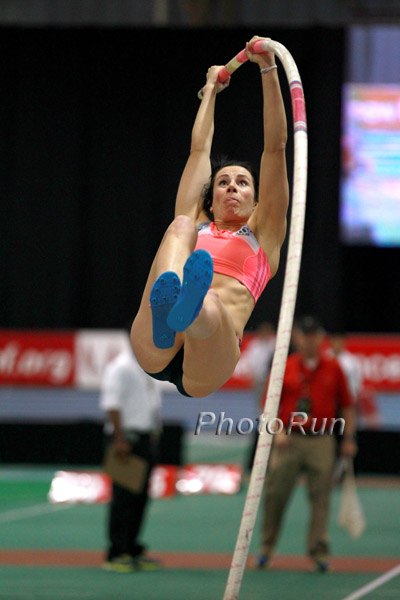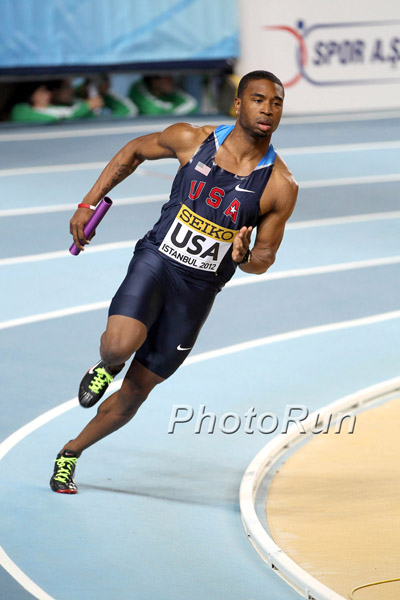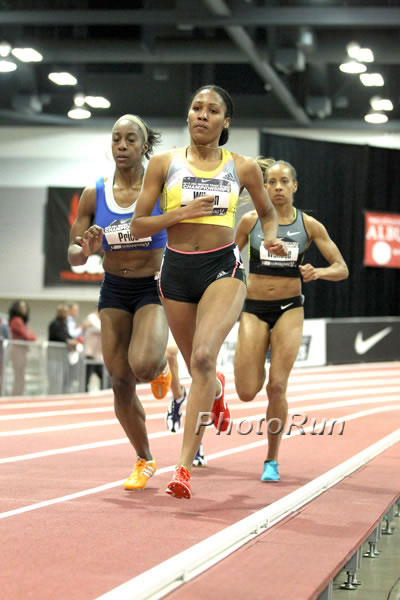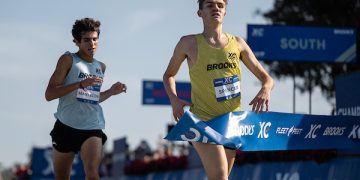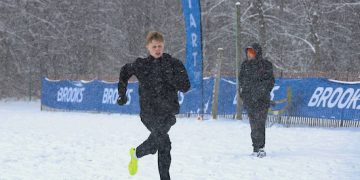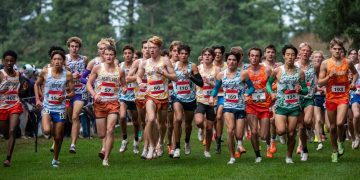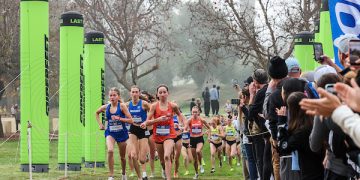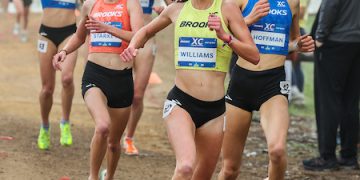How do athletes in our sport stay focused in an “off” year such as 2014? Dave Hunter reminds us, that to run, jump and throw is an esoteric activity. The US Indoor Champs in Albququerque remind Dave that, for some athletes, 2014 is already a big year.
2014 USA Indoor Track & Field Championships
Staying “On” In An “Off” Year
February 20, 2014
Albuquerque, New Mexico
Every four years when the summer Olympic Games roll around, track & field rises to the top. No problem: all the athletes are there and at their best. Even in the odd-numbered years – when the IAAF World Championships are held – track & field athletes across the board are 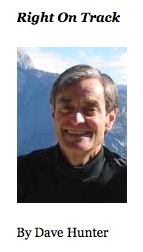 focused and purposeful in their pursuit of global titles. Ah, but once every four years – two years after the Olympic Games when there is no pinnacle global championship – something is missing.
focused and purposeful in their pursuit of global titles. Ah, but once every four years – two years after the Olympic Games when there is no pinnacle global championship – something is missing.
2014 is that quirky year in track & field that comes once in every four year cycle. Oh sure, there is the IAAF World Indoor Championships next month in Sopot, Poland. But for many – from the sport’s staunchest purists to the casual fan – the indoor version of the world’s oldest sport is a somewhat contrived substitute for the authentic outdoor competition. Make no mistake, a well-run, highly-competitive indoor gathering of elite athletes [think Millrose Games] can be an electrifying experience – even if it lacks the massive crowds, the grandeur, and even some of the traditional events [e.g. the 400H, the steeplechase, the javelin, the hammer, the discus]. All in all, it is hard not to conclude that 2014 – that fourth year with no global championship – is destined to be an off year.
As America’s best track & field athletes gather this week in Albuquerque to compete for national indoor titles and the opportunity to represent the country in the world indoor championships, several of the elite are not here – downplaying the indoor competition and utilizing this indoor season in a down year as a chance to rest, to recover fully from lingering injuries, or even to start a family.
But others soldier onward. Many – acutely aware of the fickle nature of this difficult sport and the incessant ticking of the biological clock that tracks the time they have to perform at their very best – simply don’t want to squander a precious opportunity to perform, to compete, and to reach their fullest potential.
The pre-meet press conference leading up to this weekend’s USA Indoor Track & Field Championships offered a perfect opportunity to gain insights on just how some of the elite athletes themselves view 2014 – this aberrational year in track & field.
“I think having this year as an off year is a good opportunity for rest and rebuilding,” observes Sharon Day, the reigning two-time indoor national champion in the pentathlon. Multi-eventer Day – who will be competing in the world indoor championships next month in Poland – also sees 2014 as a welcomed time to tinker and adjust. “It’s great mentally as well as physically just to have down time and to sharpen up things that need to be fixed here and there and to work on different events for me. So I think it is really a good opportunity to get that physical break, that mental break, and just sort of recharge for the next few years after that.”
For Ajee Wilson – a younger and perhaps more resilient competitor – the down year offers a unique opportunity for experimentation, a chance to refine racing skills. “Ever since my sophomore year [in high school], every summer there has always been a big goal that I’ve been working toward,” explains the American junior record holder in the 800. “It will be different not having something that is my ultimate goal.” And with a smile she adds, “So I’ll get to experiment more, have more fun with my race season, and just become a better racer.”
Monteo Mitchell – one of a handful of globally elite U.S. quarter-miler warriors – sees 2014 as a year for advance planning, for preparing mentally and physically for the looming ultimate competition: the 2016 Olympic Games. “I feel that it is good that we don’t have an outdoor [global] championship [in 2014.],” declares the 2012 Olympic silver medalist in the 4 x 400 relay. “That way we can focus solely on what needs to be worked on long term as we look forward to Rio [2016 Olympic site].” Mitchell sees other benefits from having a different type of outdoor season. “We also will have great competition – more relay events – that will be taking the place of that [the absent global championship]. We get to add cool things like that you don’t normally get to do. So I think that’s fun for all the athletes as well.”
For Olympic gold medalist Jenn Suhr who has weathered the challenges, the expectations, and the pressures of being one of world’s best pole vaulters, 2014 offers a welcomed oasis from the demands of being a performer at the very zenith of her event. “I am very excited that this is not a championship year for our sport,” states Suhr frankly. “I don’t think my heart can take any more stress and anxiety from qualifying and competing. The last three years have been extremely difficult mentally with the pressures that have been placed on qualifying in the U.S. and competing overseas.” Suhr, who placed second in Moscow to Russia’s vault czarina Yelena Ishinbayeva in last summer’s World Championships, is poised to embrace a an outdoor season with a different tempo, a different feel. “I am looking forward to a year of outdoor where there isn’t that – where you can enjoy jumping, choose meets by what you want to do, enjoy the crowd and the fans, get involved more, and simply enjoy the event.”
One foreign athlete clearly unfazed by the lack of an Olympics or World Championships this year is French pole vault king Renaud Lavillenie. Not two months into what many may have written off as a down year, the 2012 Olympic champion has set a new pole vault world record of 6.16m [20’2½”] – the highest clearance of all time, indoor or out. Competing in the Ukraine, Lavillenie not only bettered the 1993 indoor WR set by PV legend Sergei Bubka [6.15m / 20’2″], but also topped Bubka’s world outdoor global best [6.14m / 20’1¾”]. All track & field athletes should remember – as Lavillenie has demonstrated – even in a year without an outdoor global championship, they can still perform like champions.
~Dave Hunter
Author
-

Larry Eder has had a 52-year involvement in the sport of athletics. Larry has experienced the sport as an athlete, coach, magazine publisher, and now, journalist and blogger. His first article, on Don Bowden, America's first sub-4 minute miler, was published in RW in 1983. Larry has published several magazines on athletics, from American Athletics to the U.S. version of Spikes magazine. He currently manages the content and marketing development of the RunningNetwork, The Shoe Addicts, and RunBlogRun. Of RunBlogRun, his daily pilgrimage with the sport, Larry says: "I have to admit, I love traveling to far away meets, writing about the sport I love, and the athletes I respect, for my readers at runblogrun.com, the most of anything I have ever done, except, maybe running itself." Also does some updates for BBC Sports at key events, which he truly enjoys.
Theme song: Greg Allman, " I'm no Angel."
View all posts


